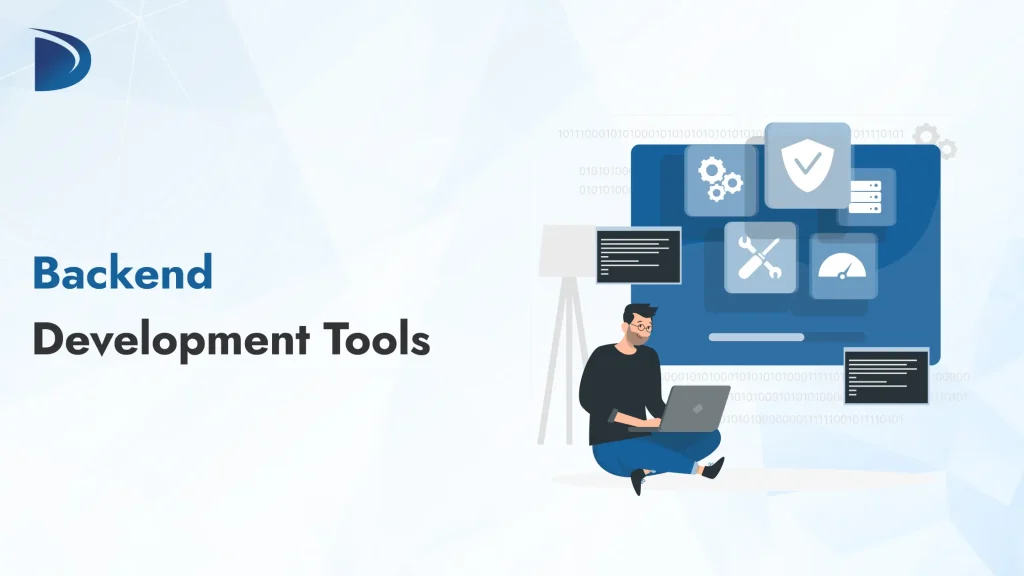Table of Contents
Backend development tools play an important role in building the foundation of modern web applications. While users interact with the front end, the backend works behind the scenes, storing, processing, and delivering data to ensure everything runs smoothly. A reliable, secure, and well-optimised backend is essential for the overall performance and stability of any website or app.
To achieve this, developers use a wide range of backend tools that handle key tasks like server logic, database management, APIs, authentication, and data security. In this blog, we’ll explore the most important backend development tools and how they help create fast, scalable, and efficient websites.
What Is Backend Development?
Backend development involves everything that happens behind the user interface. This includes managing servers, handling data from databases, writing APIs, authenticating users, and processing business logic.
It plays a vital role in ensuring that data flows smoothly between the frontend (user interface) and the backend (server and database). If you’re new to this field, understanding the basics of Backend Web Development is a good starting point.
Why Are Backend Tools Important?
Using the right backend tools allows developers to:
- Build secure and scalable applications
- Automate repetitive tasks
- Manage and store data efficiently
- Maintain a clean and organized codebase
- Collaborate better in development teams
As web applications grow in complexity, having the right toolset is essential for speed, reliability, and long-term maintenance.
1. Backend Frameworks
Frameworks are the backbone of backend development. They provide a structure for organizing code, handling HTTP requests, connecting to databases, and more.
Express.js (for Node.js)
- Lightweight and minimal
- Perfect for building REST APIs
- Popular for real-time and microservices architecture
Laravel (for PHP)
- Elegant syntax and developer-friendly
- Includes built-in features like authentication, queues, and routing
- Great for rapid development
Django (for Python)
- Highly secure and scalable
- Comes with an admin panel and ORM
- Great for complex, data-driven applications
Spring Boot (for Java)
- Enterprise-grade performance
- Ideal for large systems and APIs
- Includes embedded servers and production-ready features
Choosing the experienced website development company from the available options can speed up your project and ensure better architecture.
2. Database Management Tools
Databases store the data that drives your application. Choosing the right type of database (SQL vs NoSQL) and the right tool can significantly impact performance and scalability.
MySQL / PostgreSQL
- Reliable relational databases
- Ideal for structured data and complex queries
MongoDB
- A leading NoSQL database
- Stores data in JSON-like documents
- Highly flexible and scalable
Redis
- In-memory data store
- Perfect for caching and real-time applications
Admin tools like phpMyAdmin, MongoDB Compass, and pgAdmin help developers visualize and manage data with ease.
3. API Development Tools
APIs connect the frontend to the backend. Tools for API development make it easier to build, test, and document endpoints.
Postman
- Widely used for testing REST APIs
- Supports environment variables and automation
- Easy to collaborate with teams
Swagger / OpenAPI
- Helps generate interactive API documentation
- Automatically creates code samples
- Improves developer experience
4. Version Control and CI/CD Tools
In backend development, collaboration and automation are key. Version control helps manage changes, while CI/CD (Continuous Integration / Continuous Deployment) tools automate testing and deployment.
Git + GitHub / GitLab
- Track and manage code changes
- Collaborate with teams efficiently
Jenkins
- Automates the testing and deployment pipeline
- Highly customizable with plugins
GitHub Actions
- Built into GitHub for CI/CD workflows
- Easy setup with YAML configuration
These tools are essential for Full-Stack Web Development, where both frontend and backend must be integrated and deployed smoothly.
5. Authentication & Security Tools
Security is critical in any backend system. Protecting user data, encrypting communication, and preventing unauthorized access should be a top priority.
JWT (JSON Web Tokens)
- Secure way to transmit data
- Commonly used for stateless authentication
OAuth 2.0
- Widely used for third-party logins (Google, Facebook)
- Ensures secure API access
Helmet.js (Node.js)
- Adds security headers to protect against common attacks
Integrating proper authentication tools ensures data privacy and builds user trust.
6. Logging & Monitoring Tools
Once your app is live, you need to monitor its performance, uptime, and errors. Logging tools help identify problems before they affect users.
Loggly / Papertrail
- Cloud-based logging platforms
- Real-time monitoring and search
New Relic / Datadog
- Performance monitoring
- Alerts and analytics for backend services
Prometheus + Grafana
- Open-source monitoring and visualization
- Ideal for microservices and DevOps teams
Staying updated with the Latest Trends in Software Development includes adopting real-time monitoring to improve app stability and user experience.
7. DevOps and Server Management Tools
The backend also involves server setup and maintenance. DevOps tools help automate deployments, scale applications, and maintain uptime.
Docker
- Containerization tool for consistent environments
- Makes development, testing, and deployment easier
Kubernetes
- Orchestrates containers for scaling and failover
- Used in complex, production-ready environments
AWS / DigitalOcean / Heroku
- Cloud hosting providers
- Offer backend services like databases, functions, and storage
These tools make it easier for backend developers to focus on building features instead of worrying about infrastructure.
Conclusion
Backend development is the backbone of any modern web application. Whether you’re managing databases, building APIs, or securing user data, the right tools can make your job easier, your app more efficient, and your users happier.
From lightweight frameworks like Express to powerful platforms like Django and Spring Boot, modern web developers have a wide range of choices when it comes to backend tools. Whether you want a simple blog or a complex cloud service, understanding the core tools of backend development gives you a strong foundation for success.

